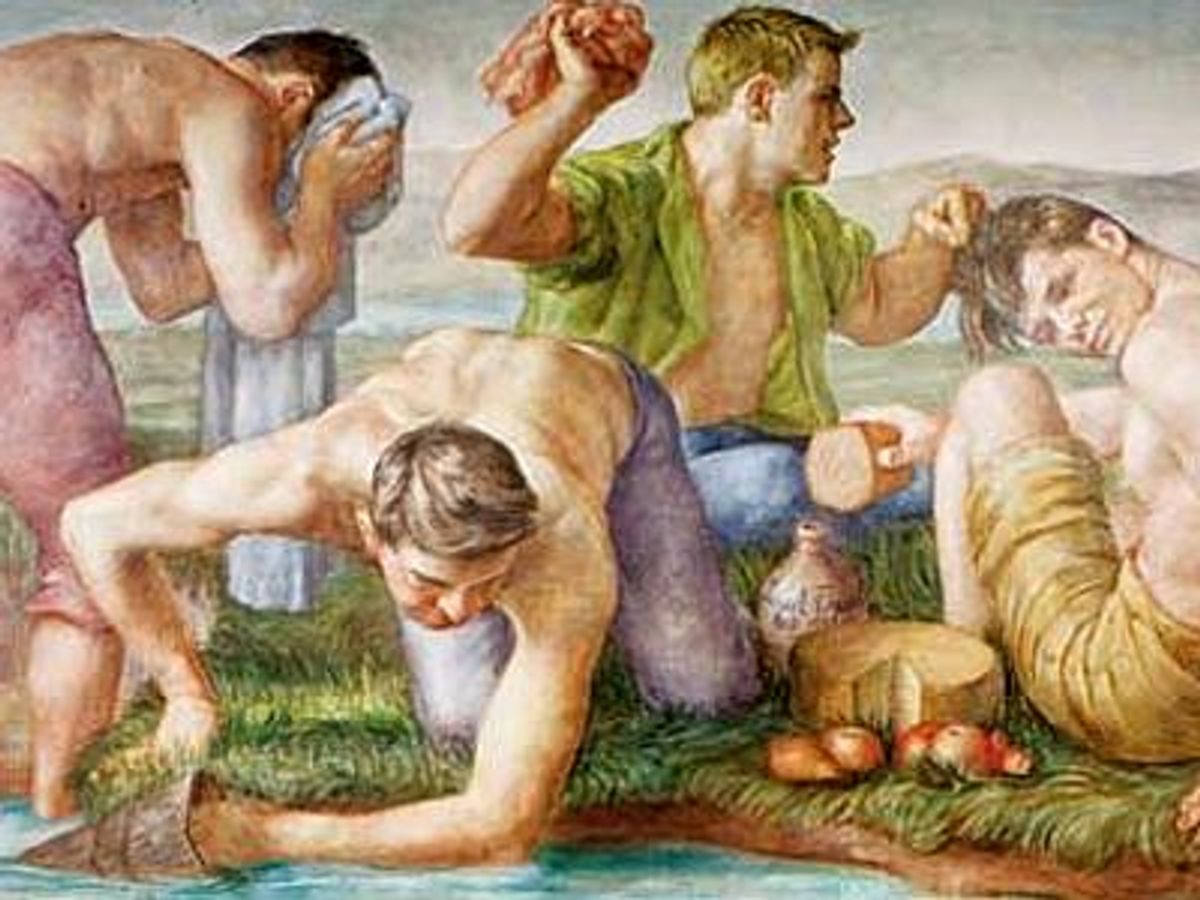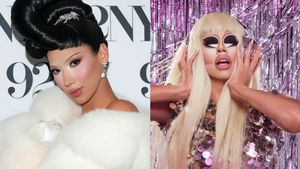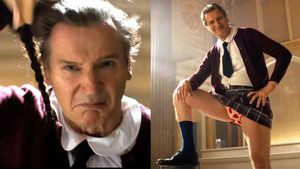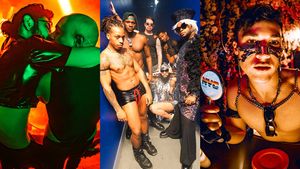Gay artists like John Singer Sargent, as well as very straight artists like Thomas Hart Benton, created large-scale works that make you wonder what's just past the lofty ideals of public art.
Part of the pride of being civilized is art funded by institutions such as museums, banks, and even the government, for the enlightenment of the general public. These works are often mythical, religious and allegorical. Because murals depicted lofty realms of thought and philosophy, they naturally tended to include naked gods, muscled shirtless workers, and androgynous angels. Also a lot of bare ass.
Viewing them now through our 21st century lenses, it is evident how much more prim and prudish the general public is. It would be implausible to think of Paul Cadmus's naked native Americans flashing themselves down on the post office patrons of today. What about the children?
In 1939, during the Depression, the Work Projects Administration created job for thousands of unemployed people that often included works of art for public spaces like courthouses and post offices. Many of these celebrated the average American working man, American history, and industry in the United States.
The corollary public art in Europe was similar in that it promoted the current political ideals of the time often veering to Olympic and physical culture. In Fascist Italy and Nazi Germany there are examples that promote a new human ideal. That didn't turn out so well, but the stylized heroic works of art still exist in some places.
Here's a look at what might grab your attention while running errands.

John Singer Sargent, Museum of Fine Arts, Boston
Born in Italy to American parents, trained in Paris, and a resident of London, Sargent became Boston's favorite painter in the 1880s. Acclaimed on both sides of the Atlantic for his brilliant oil portraits, after the turn of the century he applied his talents to other forms and media, including public mural projects. The commissions from the Museum of Fine Arts, Boston, to decorate its new building's most important public spaces--the grand staircase and rotunda-- resulted in one of Sargent's last and most ambitious works, the culmination of his career as a creator of great decorative schemes. Sargent regarded the entire space as a giant canvas and brought together all the pictorial, decorative, and architectural elements with a painter's skill and vision.
After a large trove of Sargent's male nudes were published recently, it is generally understood that Sargent was sexually oriented toward other men. To call him "gay" would be misleading, as the modern concept of a gay man did not exist then. His sensual depictions of muscled but weightless forms that verge on campy seem to be a coded message to modern eyes.

John Singer Sargent, Hercules Wrestling the Hydra

John Singer Sargent, Phaeton

John Singer Sargent, Atlas and the Hesperides, MFA, Boston
Note the ladies intertwined below Sargent's heroic Atlas.

The swimming pool at Foro Italico, photograph by Islay Lyons.
Foro Italico, formerly Foro Mussolini, is a sports complex in Rome, Italy. It was built between 1928 and 1938 as the Foro Mussolini (Mussolini's Forum) under the design of Enrico Del Debbio and, later, Luigi Moretti. Inspired by the Roman forums of the imperial age, its design is lauded as a preeminent example of Italian Fascist architecture instituted by Mussolini. There are possibly the gayest statues ever erected lining the stadium -- worth a profile on their own, but we concentrate on the murals in the swimming center here.

Foro Italico

Foro Italico, detail

A mural originally constructed in the Cincinnati Museum Terminal
German American artist Winold Reiss was commissioned to design and create two 22 foot high by 110 foot long color mosaic murals depicting the history of Cincinnati for the rotunda, two murals for the baggage lobby, two murals for the departing and arriving train boards, 14 smaller murals for the train concourse representing local industries and the large world map mural located at the rear of the concourse. Reiss spent roughly two years in the design and creation of the murals. The murals located in the train concourse were removed when the concourse building was demolished in the 1970s. The murals removed from the train concourse were then placed on display at the Cincinnati/Northern Kentucky International Airport at the cost of $1 million.

The Bathers, Duncan Grant
Duncan Grant was part of the influential British Bloomsbury Group -- an intellectual circle of writers artists and critics, who lived in the Bloomsbury area of London in the early part of the twentieth century. In 1911 Grant painted this work (and another now held in the Tate Collection; Football) for the dining room at Borough Polytechnic in South London (now London South Bank University). Source: Tate.org

Duncan Grant mural, West Wall (detail), St Blaise Chapel, Lincoln Cathedral, Lincoln, Lincolnshire, England
Grant was a conscientious objector in the First World War. Though homosexual, he had a daughter, Angelica, by his 40-year largely platonic relationship with Vanessa Bell (sister of Virginia Woolf), and several notable lovers including Bloomsbury set fellows, the economist John Maynard Keynes and writer David Garnett. His later life was spent with another Bloomsbury associate, poet and translator of the classics, Paul Roche.
The mural paintings in The Russell Chantry, St. Blaise Chapel in St. Mary's Cathedral are dedicated to St. Blaise, patron saint of wool workers and depict a fanciful quayside scene in 15th century Lincoln. They were painted in 1958, when Grant was in his early seventies and were embroiled in controversy from the start. His initial designs were amended and his open homosexuality and history as a conscientious objector were frowned upon in the early post-war years. The Chapel was kept locked from around 1964 to 1977 when the first colour Cathedral guidebook made no mention of the murals and it continued to be locked and used as a storeroom with cupboards against the walls covering the murals until 1990. Some people objected to the near nudity of the figure of Christ, modelled on Grant's homosexual lover Paul Roche and athletic young porters loading bales of wool on the quayside. Even today, some Cathedral guides omit the St.Blaise Chapel and Grant's marvellous murals from their tour. Source: Geograph.org.uk/snippet/4525

Union Station, Ogden, Utah
In 1931, Edward Laning's work formed part of the first major show at the newly formed Whitney Museum of American Art. He painted murals for the Works Progress Administration during the Great Depression. In 1980, Laning came to Ogden, Utah, to personally oversee the installation of his two 50-foot by 12-foot murals in the Grand Lobby of the historic Ogden Railway Station. The northern side depicts the Union Pacific company coming from Omaha, Nebraska, and the southern side depicts the Central Pacific coming from Sacramento, California. The National Academy of Design of New York City granted $100,000 to Union Station as his commission.

James Michael Newell, post office mural in Des Plaines, Ill.

Freedom of Speech in the City Club
When The City Club of Cleveland opened its doors to a new facility on May 12, 2000, all eyes were on the auditorium's mural, "Freedom of Speech," the centerpiece of the newly renovated space. Painted for The City Club in 1942 by noted Cleveland artist Elmer Brown, the mural's sweeping panorama represents the ideals that are the essence of The City Club: justice, freedom, honor, and shirtlessness.

Mervyn Napier Waller in the State Library of Victoria, Australia, 1928

Detail

Evolution of Corn, Lowell Houser, 1938. North wall of Ames Post Office, Iowa.

Evolution of Corn, detail.
One of the works of public art in Ames is the Post Office mural, often taken for granted by residents. Painted by a highly-talented Ames artist, Lowell Houser. The mural was created as part of President Franklin D. Roosevelt's array of New Deal programs designed to provide work for unemployed artists, create decoration for public buildings, and promote depiction of the American scene. Houser was awarded a Treasury Dept. contract for the mural on August 1, 1936. He was paid $1,320 for the completed work that was hung on April 20, 1938. This is a perfect example of the mural that has been comissioned to enlighten the public about agriculture and history that also has the kicker of male nudity.





The murals in Clark Hall were painted by Allyn Cox on a commission from William Andrews Clark, Jr. who was the donor of the building. The project took four years from 1930-1934. Mr Cox (1896-1982) was responsible for painting and designing the murals in collaboration with Clark and Lile, Dean of the Law School. It's hard in 2013 to imagine a college library with so much exposed penis. Times have changed.
The Murals
To the right, on the west wall, the three large panels in color depict a passage from the 18th book of the Iliad describing one of the scenes from the shield of Achilles. This primitive trial over the blood-price of a slain man is used to represent the Law as a means of settling disputes - weighing the conflicting interests of groups or individuals, and devining their relations to each other - a development of the idea expressed by Dike, Law and Order.
Opposite, on the east wall, is Moses Delivering the Tablets of the Law to the Children of Israel. This indicates the idea of Eunomia, the Law of the individual for himself, that which it is good for him to be.
In the four corners of the hall, over the smaller doors are four grisaille panels, each divided in two:
* On the west wall, at the left, the entire panel connotes criminal law with "Punishment" above and "Crime" below.
* On the west wall, at the right, the top part represents "Civil Law" and "Contract Law" is shown below.
* On the east wall, at the left, "Canon Law" is the upper portion and "Admiralty" the lower.
* On the east wall, at the right, is depicted "Equity staying the hand of the Common Law" above, and "Torts" below.
Source: University of Virginia Library

Edward Lanning, Blast Furnace (detail)

Edward Lanning, "The Role of the Immigrant in the Industrial Development of America," 1935
WPA Federal Art Project mural originally hung in the dining room at Ellis Island and now hangs in the Ceremonial Courtroom at the Theodore Roosevelt Courthouse in Brooklyn, New York. The panels hanging in the court represent a portion of the original work -- most of which was destroyed in the early '50s when a violent storm ripped the roof off of the building. The painting depicts the construction of the Central and Union Pacific railroads by Chinese and Irish laborers.

Paul Cadmus, Pocahontas Rescuing Captain John Smith, 1939
Some of the New Deal WPA painters found that their expressions clashed with local tastes, particularly when murals portrayed American society, past and present, in a critical light. In the case of this mural for Richmond's Parcel Post Building by Paul Cadmus, titled Pocahontas Rescuing Captain John Smith, it was male nudity that roused concern. Although Pocahontas's breast remained bared, along with the foreground Indian brave's buttocks, Cadmus had to retouch a suggestive foxhead that he had mischievously placed over another brave's groin. Source: historymatters.gmu.edu/d/6703/

Detail

Jared French, Lunchtime with Early Miners, 1938, U.S. Post Office Building, Plymouth
French painted the only nude in New Deal post office murals, despite warnings by government officials.

Jared French, The Far West, less nudity, but even less restraint

Thomas Hart Benton
Benton identified as strictly heterosexual. In fact, during much of his career, he fostered the idea that the only legitimate art was non-abstract and masculine. He promoted the idea that all European art was too feminine. He spread rumors of American Gothic artist Grant Wood's homosexuality to other colleagues and students. Google image Thomas Hart Benton Mural. You will see the results are a mass of anatomically incorrect muscle. But he manages to get a brawny, bare-chested or nearly nude man, often many of them, in most of his work.















































































































